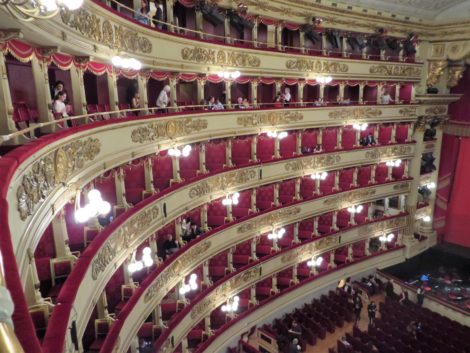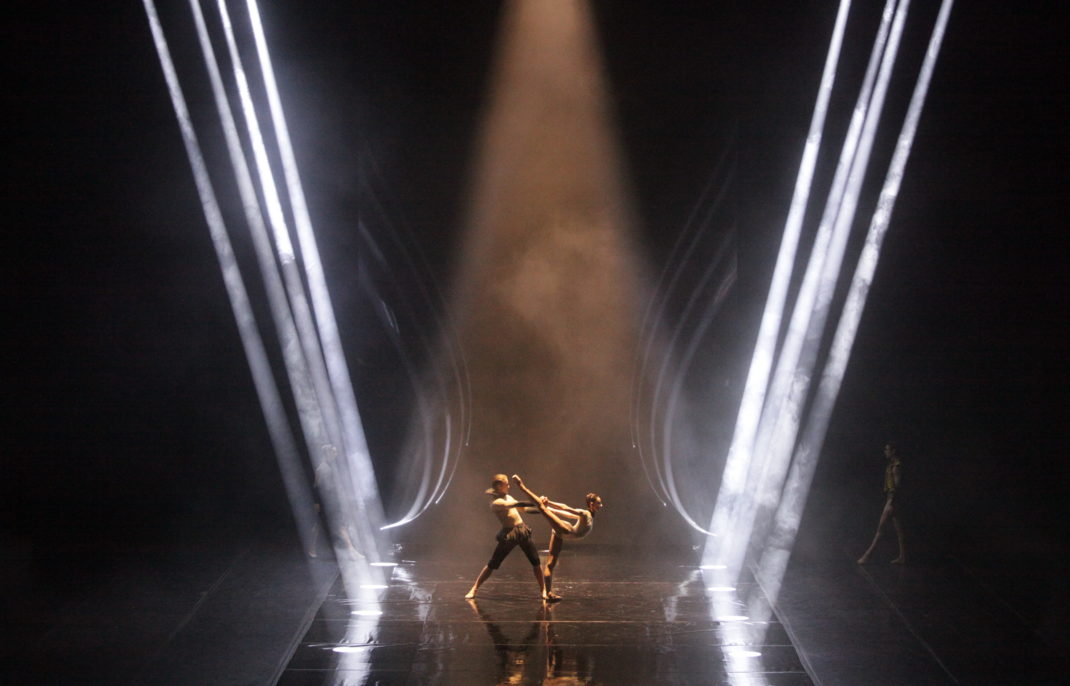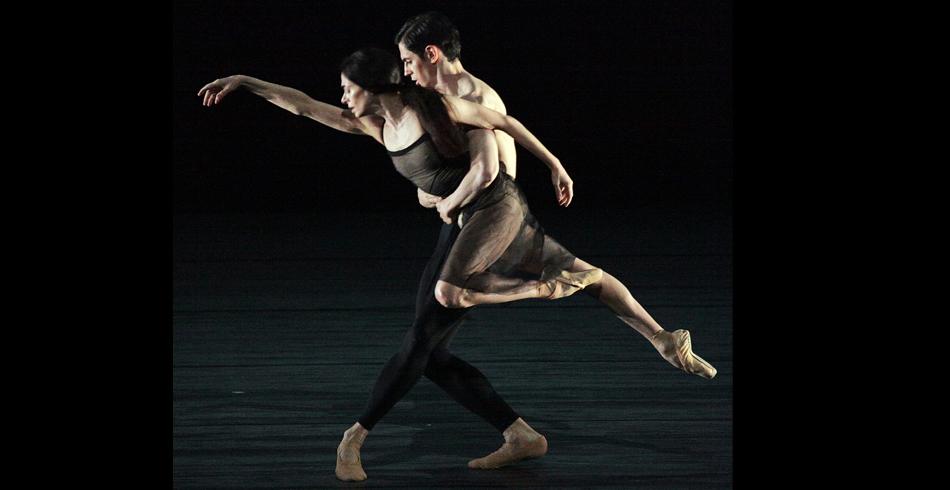20 April 2019. Teatro alla Scala, Milan
Sitting in the so-called ‘first balcony’ of Teatro alla Scala in Milan gave me a view of Wayne McGregor’s Woolf Works that I have never had before. In I now, I then, the first act based on Virginia Woolf’s Mrs Dalloway, I saw more clearly the structural elements of the set, the darkness behind those structures, and the way the elements of the set impacted on the storyline. In the second act, Becomings, based on Orlando, I had a view of Lucy Carter’s spectacular lighting design that was quite different from what I saw in earlier performances. In act three, Tuesday, based on The Waves, I was able to see McGregor’s choreographic patterns more clearly than before.
Of course I missed what I had seen on previous occasions, especially some of the finely detailed moments of choreography, and some details of personal connections between the dancers. But, like much in Milan, tickets to the ballet are expensive and, in any case, as I looked down from my central position so close to the ceiling (the ‘first balcony’ is the fifth of six semi-circular galleries that are part of the theatre), I wondered how well one could see from the orchestra stalls anyway. Down there the floor of the auditorium seemed very flat, although no doubt the stage was raked.
This post discusses the impact the new, on-high perspective had on my thoughts about Woolf Works. My previous reviews of Woolf Works are at the following links: London 2017, Brisbane 2017.

Inside the Teatro all Scala
For me, I now, I then has always had the strongest narrative element of the three acts. It follows various threads of Clarissa Dalloway’s life and loves, but does so through Clarissa’s memories. Having the view from the ‘first balcony’ of the three large wooden structures (they are like enormous picture frames) that make up the set in this act, seeing them move position, come together and separate repeatedly, gave extra strength to the notion that the story was moving through Clarissa’s life. Those who touched her life disappeared behind the frames occasionally only to reappear later, and the frames themselves seemed larger than I had previously noticed—life itself exists on a grand scale—and the figures smaller—we are are born to die while life, a greater force, continues.
I have always loved the final moments of act one where the five people who have especially touched Clarissa’s life dance together, change partners, come back to each other, then one by one disappear into the void of the darkened stage leaving Clarissa alone to contemplate her memories. The whole notion of the changing relationships that mark our lives was made clearer to me as I looked down on the action and on the visual elements that marked out the stage space.
The cast was led by Alessandra Ferri as Clarissa; Federico Bonelli as Peter, Clarissa’s early love interest; Catherina Bianchi as the young Clarissa; Agnese di Clementi as Jenny, Clarissa’s female friend; and Mick Zeni as Richard, Clarissa’s husband.

Federico Bonelli, Caterina Bianchi, Alessandra Ferri, Mick Zeni, and Agnese Di Clemente in Woolf Works Act I, 2019. Photo: © Marco Brescia and Rudy Amisano, Teatro alla Scala. This moment occurs towards the end of act one as Clariss (Alessandra Ferri) interacts with those who have shared her life.
A major characteristic of act two, Becomings, has always been Lucy Carter’s astonishing lighting design. Earlier I wrote that it ‘sometimes divides the stage space, other times it beams out into the space of the auditorium. It colours the space, and darkens it too, and laser beams occasionally shoot across the stage’. This time it seemed quite clear that many of the lighting effects indicated the multiple decades/years that are covered in Orlando. Throughout this act the dancers moved through some very clear geometrical patches of light as well as some cloudy, misty patches. And again the dancers seemed small, this time in relation to those clouds and shapes of light. Then as the act closes beams of light are projected into the auditorium. From a height they no longer blind the eyes but suggest clearly that we were now part of the ‘becoming’. Time has passed and reached ‘now’.

Nicoletta Manni and Timofej Andrijashenko in ‘Becomings’ from Woolf Works. 2019. Photo: © Marco Brescia and Rudy Amisano, Teatro alla Scala
Act 3, Tuesday, begins with a voice-over reading Virginia Woolf’s suicide note to her husband before she drowns herself in the River Ouse, her pockets filled with stones. The letter is dated Tuesday.
I have to admit that previously the choreography in this act seemed to me to be a little messy, apart from the very moving pas de deux that follows immediately after the voice-over. But, looking down on the movement patterns McGregor had created on the dancers, his intention with the choreography seemed clearer. I saw the many different variations that one might encounter in water—swirls, rips, eddies, gentle waves, tumultuous breakers, everything was there. There was no mess, just a myriad of watery patterns danced nicely by the corps de ballet of Teatro alla Scala with the participation of students from La Scala Academy.
*********************************************
Not being familiar with the dancers of La Scala it is hard to make comments about specific dancers. But I recall Nicoletta Manni from her performances in Australia in 2018 and I enjoyed her dancing in act two. I was also impressed by Timofej Andrijashenko both in act one as Septimus, the World War I veteran who commits suicide, and in act 2 for some spectacular dancing. Ferri and Bonelli I have seen before in their roles as Clarissa and Peter and once again they gave exceptional performances.
In all, I loved seeing Woolf Works from a completely different position in the auditorium. It simply confirmed my opinion that Woolf Works is a ballet that I will never tire of seeing.
Michelle Potter, 23 April 2019
Featured image: Alessandra Ferri and Federico Bonelli in Tuesday from Woolf Works, 2019. Photo: © Marco Brescia and Rudy Amisano, Teatro alla Scala. This image is from the very moving pas de deux that opens the dancing in Tuesday


Thank you for your interpretive reviews of Woolf Works. I, too, have found it a very moving piece of dramatic ballet. It shows that ballet can move in an unexpected direction and illustrates, once again, that it is a wonderful art form.
I have not had the pleasure of watching a live performance of WW and I am very grateful to the Royal Ballet for making so much of its material available on DVD and YouTube. Even small snippets of a ballet can be interesting, e.g. Mayara Magri and her 4 Hungarian Officers performing the Tavern scene from Mayerling, Natalia Osipova in a clip from Symphony in C and the wonderful rehearsal of Liam Scarlett directing Marianela Nunez and Vadim Muntagirov in his new version of Swan Lake.
It is interesting to me that Virginia Woolf’s novel Mrs Dalloway has a direct link to Ballet Russes. Lydia Lopokova danced with Nijinsky in 1905 and joined Diagelev’s BR in 1910. In 1925 she married John Maynard Keynes and so became part of the Bloomsbury Group. Some of the 13 core members of the group disliked the interloper but Virginia Woolf liked the dancer and used some aspects of Lydia’s character in that of Lucrezia Warren-Smith in the novel. In WW Akane Takada dances the role of the lonely Italian woman floundering in an uncomprehending marriage to her shell-shocked husband, William, danced in the ballet by Edward Watson. The last we see of him is when he jumps through an imaginary window on the set. In the novel William jumped to his death through the window of a boarding-house in Bloomsbury.
Keynes was very interested in art and the theatre. He very much wanted Cambridge to have a repertory theatre. After many meetings his colleagues at Kings agreed to support such a venture. The Cambridge Arts Theatre was built at a cost of 38,000 pounds. JMK loaned the project 17,500 pounds and all the loans had been repaid by the time his death in 1946. Lydia appeared in plays in the theatre and I wonder if this is where Lynn Seymour and Christopher Gable danced in Peter Wright’s production of Gluck’s Orpheus in 1957. It was produced for for the Camb. Univ. Arts Theatre Club and it was where Lynn for the first time “let go” and showed her dramatic capabilities.
Lydia & John were involved in the Camargo Society (1930 – 1933). This short lived group of ballet enthusiasts did much to keep the art form alive in England before handing over its assets to the fledgling Vic-Wells Ballet (now the Royal Ballet) founded by Ninette de Valois in 1931. The Society was the brain child of Arnold Haskell and Philip Richardson (editor of the Dancing Times). The committee included Constant Lambert as musical director, Lydia as choreographic adviser and her husband as treasurer.
JMK had two further successes that helped to establish ballet in Britain. He announced the establishment of an Arts Council in a BBC broadcast on 8 July 1945. The Council channels money to the 5 major ballet companies as well as many other aspects of the arts.
Lastly, whilst at the Bretton Woods Conference in 1944, he accepted the chairmanship of a committee to establish Covent Garden Theatre as the home of national ballet and opera companies. After months of difficult negotiations he secured the Sadlers Wells company of Ninette de Valois as the resident ballet company. Just weeks before his death, in his last public appearance, John Maynard Keynes attended the Royal Gala on 20 Feb. 1946 with Margot Fonteyn dancing the lead role in the Sleeping Beauty.
Thank you, Barry, for your thoughts on Woolf Works. First up, I think you are absolutely right about the strength of ballet as an art form. As in every art form there are some outstanding examples, and some not so outstanding. Woolf Works shows just what can be done in the hands of those who think outside the box. There is an amazing collaborative endeavour happening with the work. Design including lighting, music, choreography, dramaturgy, everything works together for the benefit of the whole. I am so lucky to have seen it live on now four occasions.
Secondly, I enjoyed reading your thoughts about John Maynard Keynes and Lydia Lopokova (and the Bloomsbury set). I must read more about JMK but I have just recently read some of the letters between Keynes and Lopokova and in the introduction to the collection of letters the author remarked that Virginia Woolf used Lopokova as inspiration for the character of Lucrezia Warren-Smith (as you have also remarked). In my reviews I have not commented much on the two Warren-Smith characters in the ballet. In many respects they are overshadowed by Clarissa (young and older), Peter, Richard and Jenny – there is so much to consider. But Edward Watson and Akane Takada did give outstanding performances with the Royal Ballet and I admired in particular Timofej Andrijashenko who performed as Septimus Warren-Smith with La Scala.
Much more to think about and I must buy the DVD! We did buy the CD of Max Richter’s music and play it often. Thanks again.